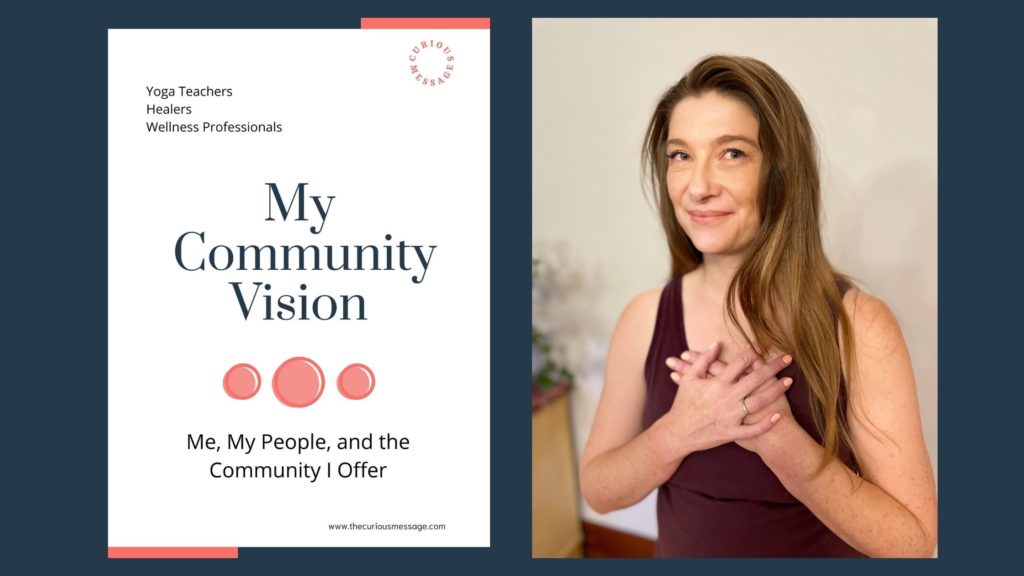And Grow Your Online Community
I imagine many yoga teachers and wellness practitioners hear “target audience” and imagine a room full of smarmy mad men zeroing in on their next gullible victims. But I’m a yoga teacher and mental health advocate, and I love creating personas. Using personas in yoga marketing (or counselling and mental health) helps you serve your people better.
This article explains:
- What’s a persona or target market profile?
- How personas help you understand and grow your community online
- How to write a persona for a yoga or mental health target market

What’s a Persona?
A persona – sometimes called a target market profile – is a detailed bio you make up about your ideal student, client, or audience.
“Ideal” means the people you’d most like to reach. Ideal people are the ones that your classes or services are best suited to help.
For example
Take a demographic like “seniors”, and flesh it out to “Megan”, a 70-year-old woman who drives to class from a middle class neighbourhood, loves Stand Up Paddleboarding and dogs, and hates crafts.
“Megan” isn’t real. She’s a composite of people in your classes, people you know, plus some educated guesses and a pinch of imagination.

Why do you need a Persona?
Why should you bother narrowing your demographic down even further? You want everyone to try your classes.
And how wise is it to base your marketing content on an imaginary person you make up?
You need to use personas for three reasons:

1. Nobody likes being treated like a demographic!
When you say your class is good for everyone, you’re lumping people together. Making them feel like they’re not special.
You’re less likely to sound boring and stereotypical in your marketing materials, if you have a “real” person in mind.
And the actual real people who fit that detailed description will feel truly seen, and motivated to respond, just as they would in a one-to-one conversation.
You may have made “Megan” up, but if you’ve been a good observer, there are real Megans out there who are tired of being ignored.

2. Personas keep your marketing consistent
Making business decisions based on the preferences of your imaginary student does seem weird. I get you.
But it’s not just a woo woo thing for yoga and mental health people.
Big Businesses Use Personas
All the big marketing departments from Coca-cola to Toyota to Kraft use target audience profiles. Expensive research proves they work.
Not only does it help writers write more conversationally, personas help those giant marketing departments with hundreds of workers stay consistent.
Every individual graphic designer and copywriter can’t choose the colour, word, or radio script they prefer. That would be chaos. Nothing would match.
Instead they all try to make “Paul” happy. What would “Paul” like?
Reigning in too many ideas
You don’t have to worry about staying consistent with hundreds of co-workers. You’re just you. (Or maybe a few)
But you do have to try to stay consistent with yourself. It’s tempting to try out every Canva template that catches your eye. Or that clever pun you thought up in the shower.
Personas like “Paul” and “Megan” become your filter. If you’re always true to “Megan”, your marketing materials will stay consistent. And consistency feels more authentic and comfortable to readers.

3. Personas bring in-person charm to an online space.
In real life, in your live classes or client sessions, you make an effort to establish a rapport with your students or clients.
You smile and get up to greet them when they arrive. You learn and remember their names, ask after their family or how their shoulder is healing. You remember that she strained after tumbling off her SUP a few weekends ago.
You need to bring that same energy and charm to online spaces to make connections and ultimately build community.
It’s a lot harder to be personal online because nobody is in front of you, giving you physical cues about their feelings or lifestyle.
Personas give you someone specific to address your remarks to. People who fit the bill will feel like you see them. People who don’t will keep scrolling.
But if you don’t address someone specific, everybody will keep scrolling.

How to Create a Persona or Target Market Profile
Common Traits
Start with the students you already have. What traits do they have in common, (otherwise known as demographics)?
- Do they tend to be teens, middle-aged, or seniors?
- Are they men, women, non-binary, a mix?
- What’s their fitness level like?

In Yoga Class
What parts of your class do they tend to like or compliment you on?
- meditations
- cueing
- gentleness
- challenge
- interesting sequences
- playlist
Are they beginners, intermediate or more experienced?
Do they like a mix of styles or are they devoted to just one?
Are they interested in the spiritual and ethical limbs of yoga, or just asana?

Outside of Yoga Class
After you’ve thought about your students within a Yoga context, spend some time thinking about who they are outside the Yoga class.
Do they tend to be parents?
Pet owners?
Business people? Artists?
Can you make any guesses about their income?

Shared Lived Experience
You’ll also want to think about their lived experience, particularly if it coincides with yours. For example, if you are Indigenous, do you tend to draw a lot of Indigenous people to your classes?
Are they coping with chronic illness, back problems, or depression?
Have they had challenges with addictions, poverty, or childhood trauma?
Are you both coming from athletic or dance backgrounds?

Bringing your Persona to Life
Start by giving your persona a name.
When you’re writing your newsletter or blog post, address it to “Megan” or “Paul”. This keeps you in that conversational tone of voice.
(Don’t forget to delete the persona’s name before sending!)
Multiple Personas
I said you shouldn’t try to appeal to everyone. But there’s nothing wrong with having two or three specific personas.
For example, at Yoga Outreach, I wrote to Tara, Laurel and Sharon.
“Tara” was a brand new yoga teacher, a little unsure of herself but eager to build up her schedule.
“Laurel” was confident as a teacher but interested in more self-development around the energetic and spiritual aspects of Yoga.
And “Sharon” was a long-time teacher with a no-nonsense evidence-based approach to yoga.
Instagram posts were more successful with Tara.
Laurel was more likely to attend workshops.
And Sharon was our biggest 25 Day Challenge fundraiser.

Basic Details
Next add basic details:
- age,
- gender,
- marital status
- Where they live
- apartment, house,
- City, small town, farm, your country, across the world.
- Who do they live with?
- Pets, relatives, partner, roommates
Job or main activity
What’s their job or profession? Are they a student? A stay at home parent? Unemployed?
What do they like about their current job or status? What don’t they like?
Passions and Worries
What do they love to do for fun?
What are their hopes for the future?
What do they worry about?
What obstacles stand in the way of their daily joy, or future dreams?
What’s their relationship with Yoga?
Or counselling, naturopathy, or whatever your service is.
Have they never tried it? Why not?
What’s their impression of it?
If they’re experienced practitioners, how experienced?
What made them start?
What kept them coming back?
What’s their favourite part?
What’s their biggest pet peeve about studios? About yoga teachers?

Writing Out your Persona
I’d recommend writing out all the details into a little story or bio, about 2 to 3 paragraphs long.
That was the expectation in my marketing classes at BCIT. And I always got top grades on my personas 🙂
Plus, when you turn your point-form scribbles into paragraphs, you’re more likely to flesh out realistic details.
It’s the difference between stick figures and properly realistic animation.
However! I’m a writer. So I would say that, wouldn’t I?
Picturing your Target Market Profile or Persona
If you’re more visually inclined, draw a detailed picture of your ideal student.
Another fun method is scrapbooking a vision board of the clients you want to serve.
Or use the modern equivalent of a vision board – Pinterest!

Benefits of Using Personas in Yoga Marketing
Personas Improve Social Media Engagement
Building up a picture of your ideal students is helpful because often, in my experience, they’re not who you expect.
I spent many months trying to appeal to wealthy donors or people recovering from trauma on an Instagram account I was managing for a Yoga nonprofit.
After some research and trial and error, I realized most of our Instagram followers were Yoga Teachers. Once I started creating posts specifically for them, our engagement blew up and we attracted thousands of followers.

Know Where to Teach
Seeing your ideal students’ traits all written out will often spark new ideas about where to teach outside the studio circuit.
People are much more likely to try your yoga class if you bring it to where they already are, i.e. the library, hospital, or community centre.
It’s much harder to convince a newbie to purchase some fancy leggings, and sign up for a studio membership, if they have to drive to an unfamiliar part of town.
Where would your persona feel most comfortable?

Know where to promote
You’ll also have a better idea about where to promote your Yoga classes. For example, Facebook and email are better channels for reaching seniors than Instagram and TikTok.
Sutra enthusiasts may be more likely to see your poster on community boards at the library than outside the gym.

Using Personas to Build Your Online Community
Just like the advice for public speaking – you’ll sound more authentic, more natural, if you imagine you’re talking to one person instead of hundreds.
Same goes online. Personas help you focus on talking to one person in your social media and blog posts, instead of hundreds or (Yikes!) thousands.
You’ll sound more like the real you that people already love in person.
And personas help you plan and filter your marketing ideas on social media or in blogs. Always think about what your persona wants to hear or know, and you’ll stay true.
Community Building Strategy
Personas are one part of a yoga marketing plan or community building strategy. To go through all six parts, download my free worksheet.


You Might Also Like these Blog Posts
Focus on Community, Not Class Size
Beginner’s Mind in Wellness Promotions

Want to Work With Me?
If you care about the wellbeing of your clients and community, I want to work with you too! Learn more about me here.
I can help you:
- create and distribute a newsletter,
- bring more traffic to your website with SEO-optimized blog posts and webcopy
- manage your social media posts
- publish a stellar Bio or About page
Want to chat first and find out if we’re a good fit? I love that. Book a free call here.
